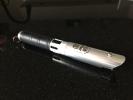I am reading through the PRIZM 3.5 manual and trying to decide how to do my crystal chamber LED.
My understanding is that if I want to run a R/G/B LED to mimic blade color, I would use a common anode and just use the same pads as the main LED (with a resistor for each leg of the CC LED).
I saw mention of using a common cathode LED, but I am not seeing how that would be wired, or the advantages/disadvantages of going that route?





 Reply With Quote
Reply With Quote





Bookmarks